Fairmount Dam and Water Works
Introduction
Text-to-speech Audio
Fairmount Water Works, dating to 1812, was declared a National Historic Civil Engineering Landmark in 1975, a National Historic Landmark in 1976, and a National Historic Mechanical Engineering Landmark in 1977. The Fairmount Dam, originally constructed in 1821, is no longer used for water power, but still holds the water supply for the city's Belmont and Queen Lane Pumping Stations. The restored Old Mill House and Engine House have served since 2003 as the Fairmount Water Works Interpretive Center, which chronicles the 200 year history of Philadelphia's water supply and houses interactive exhibits and participatory labs on water quality. Classes for schoolchildren and public lectures are also held in the interpretive center, which doubles as the Delaware River Basin's Official Watershed Education Center and the Gateway Center for the Schuylkill River National and State Heritage Area. The Fairmount Water Works is also the repository for urban watershed research and the Philadelphia Water Department's green management solutions for the treatment of storm water. In 2006, the Water Works Restaurant and Lounge opened in the Engine House and Caretaker's House. The South Garden (originally designed by Frederick Graff in 1829) and Cliffside Path have also been restored and are open to the public.
Images
Fairmount Waterworks (image from Historic Markers Database)
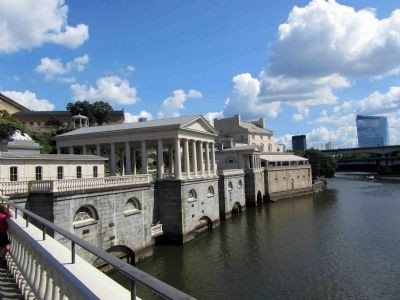
Fairmount Waterworks (image from Workshop of the World - Philadelphia)
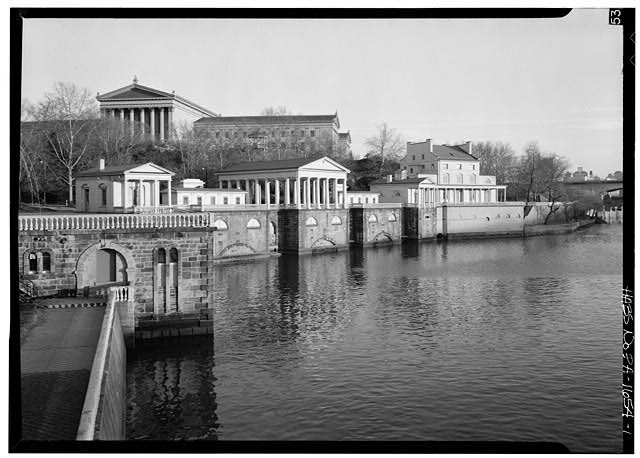
Fairmount Dam by James Cremer (1821-1893) (image from Wikimedia Commons)
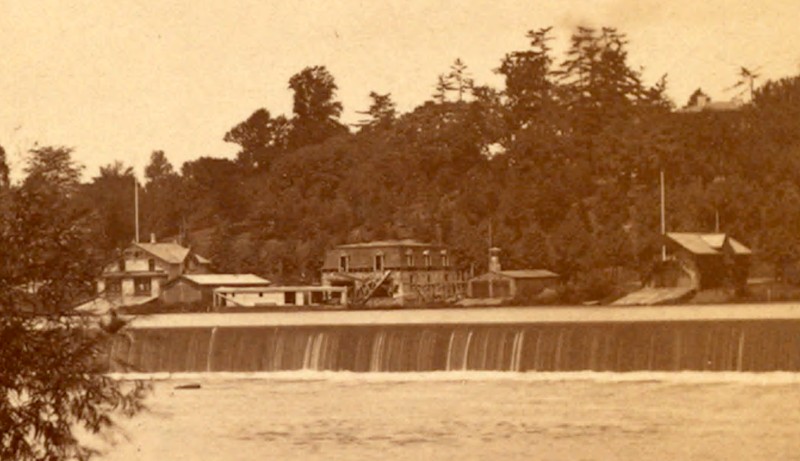
19th century painting of Fairmount Waterworks (image from Workshop of the World - Philadelphia)
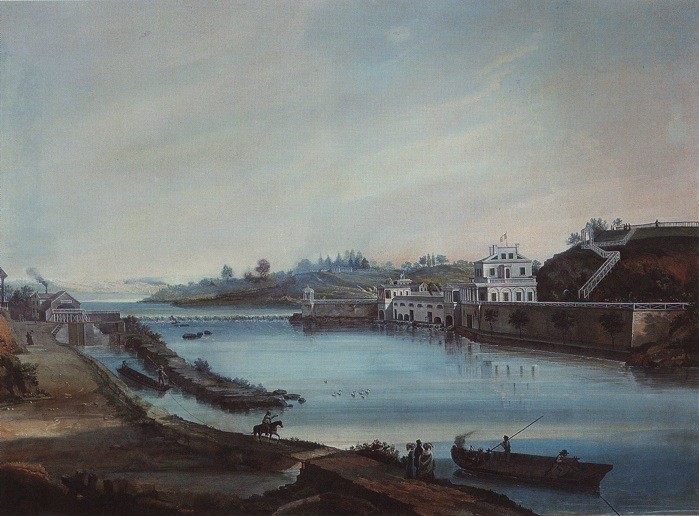
Fairmount Dam marker (image from Historic Marker Database)
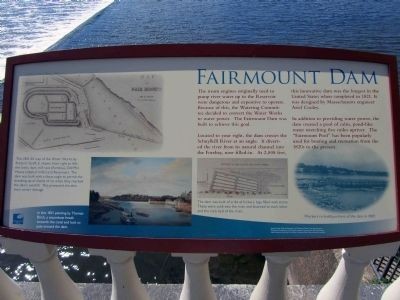
Fairmount Waterworks marker (image from Historic Marker Database)
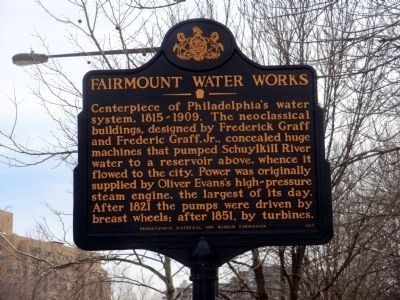
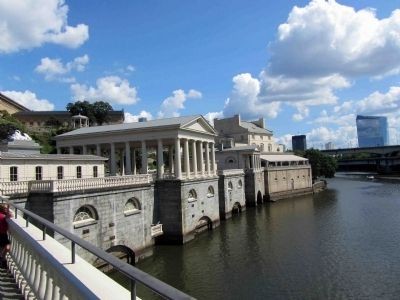
Backstory and Context
Text-to-speech Audio
In the late 18th century, Philadelphia had a higher population than any other city in America. Like all crowded cities, it faced the dangers of fires and epidemics, particularly since it lacked a water distribution system. After a yellow fever outbreak in 1793 killed one fifth of Philadelphia's population (see Lazaretto Quarantine Station for more on the epidemic), Philadelphia became the first city in the world to consider water distribution as a municipal system. In 1798, the Watering Committee of was formed by the Philadelphia Select and Common Councils, charged with the task of providing potable water for the city. Centre Square Works, engineered in 1801 by Benjamin Henry Latrobe and his assistant Frederick Graff, consisted of two steam-powered pumping stations built to draw water from the Schuylkill River to Centre Square (where City Hall now stands). However, the tanks were not large enough to keep up with the demands of the rapidly growing city.
Frederick Graff was appointed Superintendent of the works in 1805, and designed the buildings and technology of Fairmount Water Works on the east bank of the Schuylkill to supplement the older Centre Square system. The first Fairmount Water Works buildings were constructed beginning in 1812 and were operational three years later. The Federal-style Engine House held two steam engines (one in operation and one as backup in case the first failed), one a low pressure Bolton & Watts style built in part at Eagle Works in Philadelphia and the other a high pressure Columbian engine built at the Mars Works in Philadelphia. The engines pumped water 96 feet up to the two million gallon reservoir atop Morris Hill (or Faire Mount, now occupied by the Philadelphia Museum of Art). Five water mains transported water from the reservoir into the old Centre Square system, powered simply by gravity as the water flowed down the hill into the city. The original pipes were hollowed-out logs, delivering fresh water to homes and fire hydrants.
In 1818 and 1821, boiler explosions caused three deaths and financial setbacks to an already expensive (nearly $31,000 per year) and overtasked system. Following the first of the boiler explosions, the city decided to build a dam across the fast-flowing Schuylkill at Fairmount to provide water power to the pumping station. In 1819, Philadelphia purchased the water rights at the six-foot Falls of the Schuylkill from Josiah White and Joseph Gillingham. The 1,204-foot long crib dam, 270-foot earthen mound dam, millrace and head arches, and canal locks were designed by Ariel Cooley and constructed by 1821 with the help of the Schuylkill Navigation Company. At the time, it was the longest dam in the world, crossing the river diagonally and creating a six-mile long lake behind it. The crib dam consisted of hemlock logs filled with stone and planked over with oak, which were attached to one another and to the rock bed of the river, as well as the stone pier connecting it to the earthen dam, which was 15 feet higher and crossed a portion of the river where 11-foot thick mud prevented the anchoring of a crib.
Thanks to the dam, water was redirected into a set of forebays behind the millhouse, which was designed by Superintendent Graff with advice from millwright Thomas Oakes. The neoclassical millhouse held eight pumps and eight water wheels (installed individually from 1822 and 1843), each fifteen feet wide by sixteen to eighteen feet in diameter, as well as tempiettos at each end of the building, one for the Watering Committee Building and one as a Caretaker's House. Each wheel spun at around 14 revolutions per minute, with a capacity of up to 121.4 gallons of water per revolution. About 30 gallons of water through the wheels was needed to pump one gallon up to the reservoir; the excess rejoined the natural flow of the river below the dam. The cost of pumping dropped so dramatically with the switch from steam to water power that the Fairmount Water Works became the most profitable business in Philadelphia. In 1835, the Engine House was remodeled to create a public saloon with a new porch overlooking the river, and the grounds were landscaped and decorated with sculptures by Philadelphia artist William Rush, as well as fountains and promenades. The following year, three new reservoirs were added to Morris Hill. After the death of Superintendent Graff in 1846, his son, Frederick Graff, Jr. took over operations.
At high tide, twice a day, the Schuylkill River flowed backwards, filling the wells of the water wheels and stopping them for hours at a time. Replacement in 1851 of the vertical wheels with horizontal wheels powering Jonval turbines, unaffected by changes in the flow of the river, solved the problem. A new area between the Engine House and millhouse was built for the gear train for the turbines, as well as an engine room below the Engine House terrace. A new reservoir at Corinthian Avenue required the construction of a standpipe in 1852, and a New Mill House at the mound dam was built from 1859-1862 in order to accommodate three larger Jonval turbines, under the instruction of engineer John Birkenbine. The Old Mill House was also remodeled to house three additional turbines installed between 1868 and 1872; Frederick Graff, Jr. built, in the same year, a classical pavilion based on a drawing made by his father in 1820. The crib dam was replaced 38 feet beyond its original line and a pier was built to link it with the mound dam, but the original cribs remain in place to this day.
None of these measures could address the mounting problem of pollution in the Schuylkill River, however, which had concerned the city as early as the 1840s. As a precaution, the city had purchased land upriver of the Water Works to prevent industrial development, and soon after the end of the Civil War, Fairmount Park was created to protect the water quality of the river. Beginning in 1866, a series of surveys sought new water sources for the city of Philadelphia. An 1868 law proposed to increase fines for industrial pollution of the Schuylkill as far as Norristown from $100 to $1,000, but businesses petitioned against the legislature. In spite of the efforts of the city and the water company, pollution of both the Schuylkill and Delaware Rivers increased steadily. The waters ran Black, and tens of thousands of Philadelphians died of typhoid fever and cholera epidemics between the 1870s and the beginning of the 20th century. In 1905, the Purity of Waters Act prohibited sewage pollution of Pennsylvania waterways, though without a sewage treatment plant, it would be the 1950s before such pollution of the river ended. Meanwhile, the city of Philadelphia constructed water filtration plants, eliminating bacteria and chlorinating the water supply. When the plants were completed in 1909, Fairmount Water Works was decommissioned. The property went to the Mayor for use as a Public Aquarium in 1911, and all the machinery except for an 1851 Jonval turbine and pump was removed by March of the following year. The reservoirs were drained, replaced by the Philadelphia Museum of Art, constructed beginning in 1919. The standpipe and distribution arch were removed during the following decade.
The Water Works buildings served as the Philadelphia Aquarium from November 1911-1962, with the lone Jonval turbine in the former Engine House providing water to the tanks. By the 1920s, the aquarium was one of the four largest in the world. The Engine House served as an office building with a lecture hall containing tanks from the 1893 Chicago and 1905 St. Louis Fairs. Freshwater tanks were housed in the Old Mill House and saltwater tanks in the New Mill House. The forebay became a winter home for seals from New Jersey. After the aquarium closed in December of 1962, the Water Works buildings were converted for use as the John B. Kelly Pool, which served competitive swimmers and Philadelphia students as a practice facility. The efforts of Susan Meyers and the Junior League of Philadelphia in the 1970s led to the restoration of the Water Works as a historic site, and the passage of the Clean Water Act in 1972 led to the Philadelphia Water Department's need for a permanent educational facility on public stewardship of urban watersheds. It was decided in 1974 that the Water Works would be restored as a recreational and educational facility with an emphasis on its historic utility.
Fairmount Water Works was declared a National Historic Civil Engineering Landmark in 1975, a National Historic Landmark in 1976, and a National Historic Mechanical Engineering Landmark in 1977. Archaeological investigations on both the Water Works and the dam began in the 1970s and are ongoing. The Fairmount Dam, now maintained by the U.S. Army Corps of Engineers, has been rebuilt in concrete. Though it is no longer used for water power, the dam still holds the water supply for the city's Belmont and Queen Lane Pumping Stations. The six-mile lake held back by the dam, known as the Schuylkill Pool, allows space for the Boathouse Row based Schuylkill Navy and Philadelphia Canoe Club. The original locks on the west bank were demolished in 1950, but a portion of the guard lock wall remains. Environmental legislation led to significant reduction of pollution of the Schuylkill, which became Pennsylvania's first Scenic River in 1978 and a National Heritage Area in 2000. The restored Old Mill House and Engine House have served since 2003 as the Fairmount Water Works Interpretive Center, which chronicles the 200 year history of Philadelphia's water supply and houses interactive exhibits and participatory labs on water quality. Classes for schoolchildren and public lectures are also held in the interpretive center, which doubles as the Delaware River Basin's Official Watershed Education Center and the Gateway Center for the Schuylkill River National and State Heritage Area. The Fairmount Water Works is also the repository for urban watershed research and the Philadelphia Water Department's green management solutions for the treatment of storm water. In 2006, the Water Works Restaurant and Lounge opened in the Engine House and Caretaker's House. The South Garden (originally designed by Frederick Graff in 1829) and Cliffside Path were restored to an 1875 landscape, including the restored Marble Fountain (out of order for over 115 years), 1848 Gothic-style Graff Memorial, and bust of Frederick Graff, with reproduction light fixtures, benches, and railings added. The cast-iron railings along the Cliffside Path to the Philadelphia Museum of Art were recreated and the path repaved and stabilized.
Marker Inscriptions:
Fairmount Dam: The steam engines originally used to pump river water up to the Reservoir were dangerous and expensive to operate. Because of this, the Watering Committee decided to convert the Water Works to water power. The Fairmount Dam was built to achieve this goal. / Located to your right, the dam crosses the Schuylkill River at an angle. It diverted the river from its natural channel into the Forebay, now filled-in. At 2,008 feet, this innovative dam was the longest in the United States when completed in 1821. It was designed by Massachusetts engineer Ariel Cooley. / In addition to providing water power, the dam created a pool of calm, pond-like water stretching five miles upriver. The "Fairmount Pool" has been popularly used for boating and recreation from the 1820s to the present.
Fairmount Water Works: Centerpiece of Philadelphia's water system, 1815-1909. The neoclassical buildings, designed by Frederick Graff and Frederic Graff, Jr., concealed huge machines that pumped Schuylkill River water to a reservoir above, whence it flowed to the city. Power was originally supplied by Oliver Evans' high-pressure steam engine, the largest of its day. After 1821 the pumps were driven by breast wheels; after 1851, by turbines.
Sources
Fairmount Water Works. "About Us." Fairmount Water Works. Accessed June 01, 2016. http://fairmountwaterworks.org/. Fairmount Water Works Film from Philadelphia Water. Directed by Mykola Kulish. Philadelphia: Water Works Theater. Vimeo. https://player.vimeo.com/video/95017596 Gibson, Jane Mork. "Fairmount Dam." Workshop of the World. 1990. Accessed June 01, 2016. http://www.workshopoftheworld.com/fairmount_park/dam.html. Milask, Eric. "Fairmount Dam Marker." Historic Marker Database. August 9, 2013. Accessed June 01, 2016. http://www.hmdb.org/marker.asp?MarkerID=67450. Morfe, Don. "Fairmount Water Works Marker." Historic Marker Database. April 22, 2015. Accessed June 01, 2016. http://www.hmdb.org/marker.asp?MarkerID=82618. Philadelphia Water. "Schuylkill River Watershed History." Philadelphia Water. Accessed June 01, 2016. http://www.phillywatersheds.org/your_watershed/schuylkill/history.
